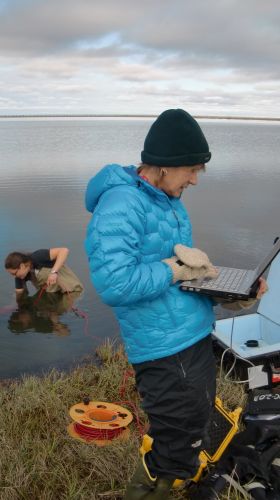As described in my post "Arctic Sunlight and Carbon Release", the tundra is a large carbon sink, storing decayed plants and animals in the frozen ground. As soil thaws and carbon moves from the ground into the watershed, carbon enters water as a dissolved organic carbon (DOC). Researchers study what factors affect the release of carbon dioxide (CO2).
The cornerstone piece of Dr. Cory's research is studying how sunlight interacts with (DOC) to convert carbon to CO2 in streams and lakes. One important piece of information the team must know is how deeply sunlight penetrates into a lake or stream.
Dr. Cory's team uses a C-OPS instrument to measure wavelengths of sunlight in the ultra-violet (UV) and visible range (e.g. from 300 - 700 nm) in streams and lakes. The C-OPS is lowered to different depths and recordings taken.
 Katie using C-OPS in Silhouette Lake
Katie using C-OPS in Silhouette Lake
The DOC in water acts as a filter for sunlight. Some, but not all, UV and visible waves are blocked as sun moves through the water column.
 Using C-OPS to measure light waves
Using C-OPS to measure light waves
Another way to examine how sunlight is filtered by DOC in water is simply by watching light as it changes with increasing depth. Here's a video that demonstrates how the color of sunlight changes under water. The video was created by connecting a Go Pro camera to a post, then lowering the post in increments of 25 cm to a final depth of 125 cm below the Toolik Lake surface. The camera is stopped just at and below the water's surface. Notice how the light changes at each stop.
http://
Check back for lessons and labs to that will allow you to incorporate more polar science into your classroom.

